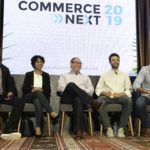Today’s marketing landscape is not easy to navigate. Increasing competition and overly-saturated digital marketing channels make it difficult for brands to get their message, product or service seen by the right people. According to HubSpot, 87% of people say there are more ads today than two years ago.
To learn how leading brands are breaking through the noise, we sat down with Naomi Jacobs of Qurate Retail Group, Bree Casart of West Elm, Mark Chou of Away and Tomer Tagrin of Yatpo at last year’s CommerceNext conference to learn more about their tricks of the trade. These four panelists shared how they successfully navigated the complex marketing landscape in 2018 and how their experiences will prove valuable as they take on new challenges in 2019.
Panel Question: What are the biggest challenges you are facing today compared to two years ago? How have you adjusted your strategy to face these challenges?
Compared to two years ago, the digital landscape today has become increasingly demanding, overcrowded and complex. This kind of over-competition has created an astounding change of pace that can make it difficult for businesses to keep up.
Naomi Jacobs, Director of Social Media Strategy at Qurate Retail Group, agreed, “On one hand, it feels like an incredible opportunity, but on the other side, it can feel overwhelming and exhaustive to figure out which direction to go.”
The panelists share how they have embraced these changes by making the following four adjustments to their strategies:
1. Portfolio diversification
It’s vital not to become overly dependent on one channel because of market saturation. For Mark Chou, VP Growth Marketing and E-Commerce at Away, this means leveraging offline and hybrid channels such as direct mail and podcasts in addition to traditional online channels like Facebook and Google.
2. Automation
Automation can save brand time in an environment where time is becoming an increasingly finite factor. Tools that use AI and machine learning to handle time-consuming and tedious tasks free up time for teams to think strategically.
3. Concise messaging
“The rule of 7 is now the rule of 30,” pronounced Bree Casart, VP eCommerce and Digital Marketing at West Elm, explaining marketers used to need their message heard only seven times before a purchase was made. Casart argues that from a competitive point of view, businesses are experiencing pressure from the bottom with new digital-first DTC brands and from the top from well-established brands like Amazon. From a consumer point of view, attention spans are waning. These factors combined mean that brands should be more specific and concise with their messaging in order to stick in their customer’s minds, and now it may take far more marketing touches before a purchase is made.
4. Authenticity
As brands and product/service offerings become oversaturated, simply offering a new product is not enough. Brands must work on becoming authentic and unique within their niche to capture their target market.
Panel Question: How are your brands thinking about a holistic view towards marketing attribution when you’re leveraging tactics that live outside of digital marketing?
Marketing attribution is a common topic in the business community. Although advancements have been made, no one has quite figured it out yet. Tools like Google Analytics are great for business that are just beginning to understand their marketing attribution, but when working with non-digital platforms, GA is not enough.
Chou explains, “When we started spinning up podcasts, digital radio and television, relying on Google Analytics alone became an imperfect tool. We have shifted our focus on aggregating our data in a consolidated way. We use Amazon Redshift and run a lot of our models out of Looker to leverage our data.”
Panel Question: How are you building and communicating with your community today in a way that’s different from a few years ago?
Community has been dictating everything from the way brands communicate with their customers to the way products are being sold. Glossier is a leading example of community engagement. They actually involve their customers in product development.
Here’s how the panelists have been using different techniques to build their community:
Leverage social media
Jacobs explains how 40 years ago when someone wanted to be a part of the experience at QVC, they would pick up the phone and leave a review. Today, they stream all of their live shows across 40 different Facebook groups. Not only can Facebook groups give consumers a platform to share their thoughts, but they also provide brands with valuable customer data on the types of people entering and contributing to these groups. “We’ve even changed the entire trajectory of a show because of customer feedback,” says Jacobs.
Create micro-communities
Micro-communities are a great way to create small, manageable feedback loops from the customer to the business. West Elm created the Shopkeeper program to empower their store associates to listen to customers in their specific geographic area. These mico-communities allowed West Elm to customize individual shops to the needs of the immediate communities. Casart further explains, “In Miami, we heard that customers were looking for White Leather, and this wasn’t something that was part of our assortment. It’s a very specific experience for those communities.”
Use customer reviews
Leveraging customer reviews using Natural Language Processing to analyze common suggestions, keywords, and more can empower brands to make decisions centered around community needs. Tomer Tagrin, Founder and CEO at Yotpo, uses the example of their client Adore Me, a women’s intimates company. Using NLP, they were able to discover that a lot of their reviews were along the lines of “I am so happy that my boyfriend/husband bought me this lingerie.” Finding out this information inspired them to launch a highly successful couples intimates line. Targin added, “our ability to provide organized customer feedback to brands has been one of the most important things on how to build and understand a community.”
Panel Question: What makes a great partnership and how do you determine its success?
![]()
Jacobs explains how brands, big and small, come to QVC because it gives them a platform to tell their story. This is demonstrated in their partnership with the creator of Beachwaver, a rotating curling iron. The founder created the product in her home with her sisters right after she graduated from college. Jacobs further illustrated the idea, “She came to QVC because her rotating curling iron in a box on a shelf wasn’t telling a story, and it is an incredible story. And the story is really what sells the product.”
Watch the panel “Marketing Playbooks For All Sizes” from the CommerceNext 2018 conference:
In the future, brands should cultivate these partnerships by focusing on Influencer Commerce marketing. Providing a platform for influencers to share their products is what creates successful partnerships.
Looking Ahead
Your marketing playbook will evolve throughout the course of this year, and rightly so. As we’ve seen in the examples above, multi-touch campaigns, community and consumer engagement in your brand strategy are more important than ever. Each of these tactics are opportunities for brands to benefit in an age where it’s difficult to have a product and story heard.
Are you interested in learning what companies are noticing about consumer behavior in 2019? Join us for the CommerceNext marketing conference on July 31st & August 1st of 2019! Apply to attend here.
Related Posts
-
eMarketer’s Retail Industry Trends 2019
According to eMarketer, Americans are poised to spend $586.92 billion…
-
Customer Experience and Community as the Ultimate Marketing Tool
If you spend time online, you’ve undoubtedly heard of cult-favorite…
-
Tailoring Your Performance Marketing for Attribution
Attribution is one of the most sought-after yet daunting discussions…




